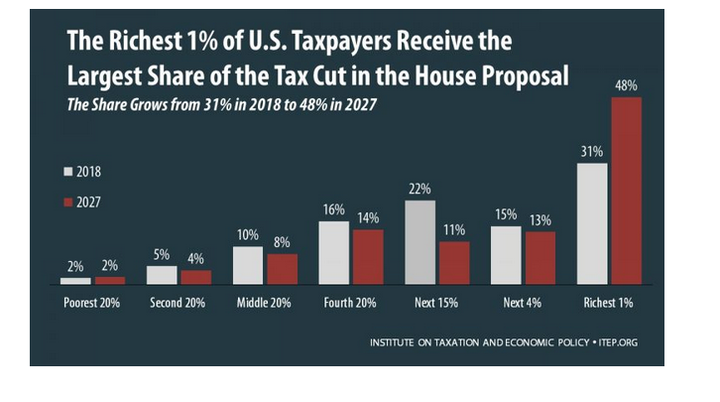
Imagine that every American citizen, every business, and every bank in the U.S. were to completely empty out their hordes of hard cash: coins and bills. Pile up every bit of U.S. currency stashed under granny’s mattress, in the kids’ piggybanks, in bank vaults and in the cash registers at your local 7-Eleven, gas station, grocery, and liquor stores. Unearth it all: the $1, $2, $5, $10, $20, $50 and $100 bills, and every single coin ― dollars, half-dollars, quarters, dimes, nickels, and pennies— currently in circulation in all 50 states.* Then take about half of it and, over 10 years, deliver this cash in armored cars emblazoned with the GOP elephant to the super-rich 1-percenters, large investors and corporations. Meanwhile, keep telling the rest of America, many of whom live paycheck to paycheck or carry high debts, that this tax cut is great, great, great!
Here’s another jaw-dropping metric: The proposed $1.5 trillion cut is equal to about one in every 13 dollars in the U.S. economy (counting all assets), given that the U.S. GDP is about $19.5 trillion.
1 PERCENT OF AMERICANS WIN “BIGLY”
Follow the money! Many Americans may win or lose in small ways from the tax plan. The stratospherically wealthy will win bigly.

The GOP tax plan spans a decade. At the end of the decade, the richest one percent of Americans will have received half of the $1.5 trillion cut.
The Washington-based Institution on Taxation and Economic Policy report on the GOP plan, “Richest Americans Benefit Most from The Tax Cuts and Jobs Act,” concluded:
“The richest 1 percent (would) receive 31 percent of the entire value of the tax cut in year one. By 2027, the wealthiest 1 percent would get nearly half of the share of the tax cuts (48 percent).”
The plan shifts $720 billion to those earning over a million dollars annually. Corporations and major shareholders would benefit hugely.
Not every millionaire supports this. Calling it “a tax plan written for the wealthy, by the wealthy” and “a payoff to wealthy campaign contributors,” Morris Pearl, chair of Patriotic Millionaires and former managing director of BlackRock, said:
Eliminating the estate tax and the Alternative Minimum Tax will help some of America’s wealthiest billionaires and millionaires reduce their tax obligation to essentially zero, shifting all of the burden of funding the country to the middle class.
WRAPPING YOUR HEAD AROUND $1.5 TRILLION
Dr. Seuss could write a book about the number trillion! It has so many zeros, a funhouse dozen. A trillion is 1,000,000,000,000. It’s a thousand times a billion. A billion is a thousand times a million! Grasping a trillion is like looking at mirror inside a mirror inside a mirror, going on forever. Alas, the GOP tax plan is not child’s play. Here are ways to understand it:
Comparisons for $1.5 Trillion: Big Food, Pharma, Finance
I don’t understand big numbers. So I sat down to figure out how much money $1.5 trillion is. That’s the amount the Republicans want to cut in their historic tax overhaul. Here’s what I found out:
Food: $1.5 trillion is spent nationally on food and beverages in grocery stores, retailers and on away-from-home meals and snacks (source: USDA).
Finance: The U.S. Treasury bill market is worth about U.S. $1.5 trillion (source: Bloomberg).
Women, black and Latino sectors: An estimated 9.4 million U.S. women-owned businesses generated $1.5 trillion in 2015 (source: American Express). By 2021, the buying power of black consumers is projected to hit $1.5 trillion (source: Nielsen). That’s also about the size of today’s Latino market.
Cyber markets: By 2015, e-commerce was worth about $1.5 trillion (source: Statista). Personal data generated by new “smart” or “connected” cars will be worth about $1.5 trillion by 2030 (source: Forbes). AT&T predicts that the business value of “smart cities” could reach $1.5 trillion globally (source: Business Journals).
War: The Congressional Budget Office calculated that the Afghanistan and Iraq wars and related conflicts cost $1.5 trillion between 2001 and 2015 (revised upward to $4.8 trillion last year (source: U.S. News & World Report).
Global pharma: By 2021, the global prescription drug market is predicted to reach $1.5 trillion (source: Business Insider).
Translating $1.5 Trillion Into Pocketbook Lingo: Chocolate Bars, Homes, Salaries
Time/Money/CNN recently tried to translate $1.45 trillion—the sum earmarked for the controversial F-35 fighter jet—into understandable terms. They found it would buy a $4,500 present for every American, or four years health insurance premiums at $1,070. It would wipe out student loan debt. It would foot half the repair bill for the nation’s infrastructure or the recovery from 14 massive hurricanes. It would pay Beyonce to perform nightly for a millennium.
In 2011 Kiplinger parsed what $1 trillion dollars might buy: a new car for about two in five American families; or more than 5 million new homes; or 140 billions of hours of minimum wage labor; or 18 million teachers’ salaries; or 10,700 years of salaries for members of Congress. Or it could pay the salaries of 100 times more U.S. Army privates than serve. Or it would buy more than 1.3 trillion chocolate bars. $1 trillion would give $6.2 billion per month to one person for their life. $1 trillion equals $1 million spent every day for 3,000 years.
Adding It Up
The Tax Cuts and Jobs Act puts the U.S. government on a 10-year, $1.5 trillion diet, increasing the deficit and triggering cuts in education, environmental health, Medicare and Medicaid, while delivering a boondoggle to the already rich.
If you’re not in the 1 percent, then take a close look at what the GOP tax plan will do to your family — and your country.
Compare what’s in your piggybank with what the very wealthy already have and what this plan offers. And then pick up the telephone and call your elected officials in Congress to demand they oppose the GOP tax bill.
(*It’s almost a poetic accident that the proposed tax cut approximates the value of all the American money in circulation today; the Federal Reserve says there were “approximately $1.58 trillion” coins and bills circulating as of September. )
